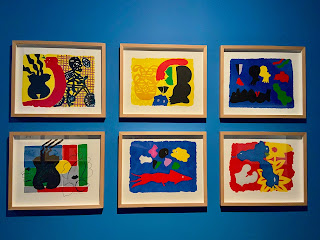All around Campo Grande there are big municipal institutions including the Universidade de Lisboa, and the Biblioteca Nacional de Portugal (think Library of Congress). There are also some nice small museums; our survey of three of them is below.
Museu Bordalo Pinheiro
Rafael Bordalo Pinheiro (1846-1905) is a well-known Portuguese ceramist, illustrator, and satirist. There is a very nice museum dedicated to him and his work at the north-east end of Campo Grande; there is an older villa fronting the park, and a larger, modern structure behind. The current show is called "Pé d'Orelha: Conversas entre Bordalo e Querubim"; a conversation between Pinheiro and a contemporary ceramist and illustrator, Querubim Lapa (1925-2016). Interestingly, the literal translation of "pé d'orelha" is "foot of the ear", but is equivalent to the idea of having a heart-to-heart talk – I imagine two people laying head to foot. Some of the work you see in the images are by Lapa.
The show is wonderful, full of color and character. Some of the ceramic art pieces by Pinheiro are stunning in their detail and craftsmanship. The older "villa" part of the museum contains a display from the museum's collection, with some amazingly large pieces, along with Moorish-styled and art nouveau tiles.
Museu de Lisboa, Palácio Pimenta
On the other side of Campo Grande, the north-west end, there is one of the City Museums of Lisbon (Museu de Lisboa), the Palácio Pimenta (see the stair lobby above). This museum is associated with the Teatro Romano and a few other museums under the City Museums banner. Unfortunately, the main level is closed for reinstallation, so we content ourselves with a presentation of drawings, documents, and ephemera documenting the development of the city. Outside the Palácio, there is a large formal garden. The garden is home to a family of peacocks as well as a gallery of contemporary art that does not seem to be accessible from anywhere but the Palácio.
To one side of the Palácio, the garden is walled-off, and inside there is another formal garden filled with ceramic pieces by Pinheiro: in the fountains and pools, in the tall hedges, hanging from the knotty trees, and on the sun-lit Palácio itself are all manner of crabs, frogs, monkeys and lizards.
Biblioteca Nacional de Portugal
At the opposite end of Campo Grande, the south-west end, is the Biblioteca Nacional de Portugal; it's basically on the other side of the park from our apartment. Inside the Biblioteca is a terrific gallery currently presenting a print show: "Volta ao Mundo: Obra Gráfica de José de Guimarães". The gallery rooms and passageways are colored and shaped like pieces from his prints. The primitive masks and art pieces appear to be inspirational items from the artist's collection.
The artwork is bold and colorful, and the imagery is reminiscent of the big modernists: Picasso (specifically named), Matisse, and Miró. Other well-known contemporary artists seem to be paraphrased: Robert Indiana, Arthur Dove and Kara Walker come to mind. The Kara Walker connection hits me funny as there may be some misplaced "American" concern for cultural appropriation, but reading more about de Guimarães, it seems much of this imagery expresses his criticism of Portugal's colonial past.
The show's title suggests a trip around the world; the work and the show are both very compelling.

























No comments:
Post a Comment